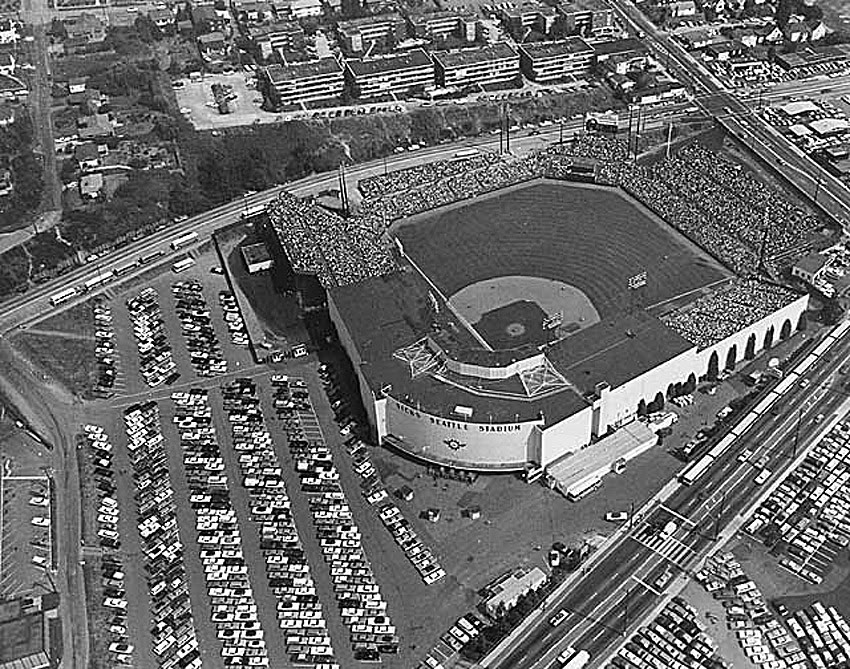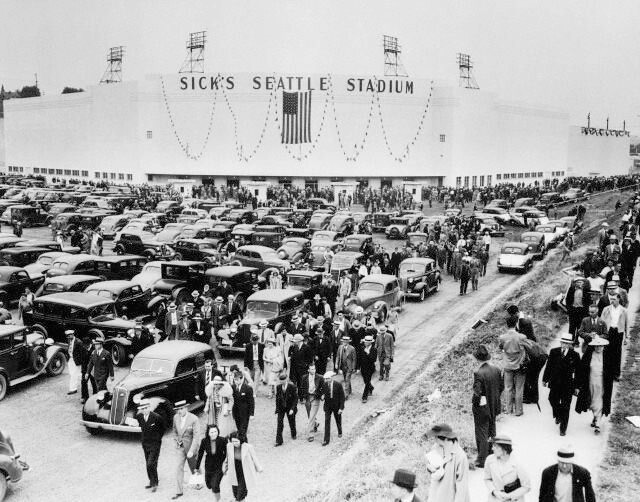The year 1969 was a big one in Major League Baseball, as four expansion teams were added to the mix. This month we’re looking back at the four expansion ballparks. Last week it was Kansas City’s Municipal Stadium, the only one of the four to have previously hosted Major League Baseball. This week: Sicks’ Stadium.
Another temporary facility pressed into service during a rushed expansion, Sicks’ Stadium may be barely a footnote in MLB ballpark history, used for a single season by a team best remembered for what happened off the diamond, not on the playing field.
Sick’s Seattle Stadium—later known as Sicks Stadium and Sicks’ Stadium, to honor the entire Sicks family—opened in 1938 at the old Dugdale Stadium site at the northeast corner of Rainier Avenue and McClellan Street. Beer magnate and Tacoma native Emil Sick was recruited to buy the PCL Seattle Indians and invest in a new ballpark soon after his arrival in the city. Sick, whose brewery empire stretched across the western United States and Canada, including Spokane, Great Falls (MT), Lethbridge (Alberta), Regina (Sask.) and Vancouver, saw baseball as the perfect vehicle for promoting his newly acquired lines of beers, including Rainier. He soon rebranded the Indians as the Rainiers and set out to build a palace for his team.
Constructed in only three months, the $350,000, 12,000-seat concrete-and-steel ballpark opened to instant acclaim, hailed as one of the finest ballparks in all of Minor League Baseball. The Rainiers were a success, winning five PCL pennants (1939, 1940, 1941, 1951 and 1955) and annually leading the minors in attendance. For Sicks, it was an unqualified success: Rainier Beer was promoted during the game, on Leo Lassen radio broadcasts where “The Great Gabbo” extolled the virtues of Rainier Beer, and via billboards and signage both within and outside the ballpark.
Over time the beer world changed, with the rise of national brands like Schlitz and Hamm’s taking market share from smaller regional breweries. And with Minor League Baseball struggling in the 1960s and 1970s, the once-immaculate Sicks’ Stadium became an aged facility. The Boston Red Sox bought the Rainiers and Sicks’ Stadium in 1961, only to flip them to the Angels in 1962. The Rainiers name was dropped, and the ballpark deteriorated under absentee ownership.
A Most Unlikely MLB Venue
By the early 1960s Seattle was seen as a potential major-league market, but the lack of a suitable long-term facility hurt the Emerald City’s chances of landing a team. Owners of the Cleveland Indians and the Kansas City Athletics passed on moving their teams to Seattle and Sicks’ Stadium, with A’s owner Charlie Finley advising city leaders to pursue a new ballpark if they wanted to land a major-league team.
So they did. Though voters had rejected two referendums authorizing a new domed stadium, by 1968 opinion had turned and a $40-million King County stadium proposal passed. Why? The promise of Major League Baseball in the form of a 1969 American League expansion team.
Major League Baseball expansion work officially began in 1967, when Finley proposed moving his Athletics from Kansas City to Oakland. Finley’s tenure as the A’s owner was a rocky one; after an early honeymoon period, local fans tired of his unstable management of the team, both on the field and in the front office. Kansas City officials had been working on a plan for a new ballpark to replace Municipal Stadium, but Finley didn’t believe they would follow through if he still owned the team. His move triggered a series of moves that included an influential U.S. senator, Stuart Symington (D-MO), claiming he’d work to revoke MLB’s antitrust exemption if Kansas City had to wait until 1971 for expansion, MLB’s preferred timeline. So MLB forged ahead with expansion, pressing older facilities like Municipal Stadium and Sicks’ Stadium into service.
The expansion Seattle Pilots were owned by Pacific Northwest Sports, controlled by former Indians owner William Daley and brothers Max and Dewey Soriano, a former Pacific Coast League president and Seattle Rainiers GM. Their game plan called for the construction of a new stadium opening for the 1971 season, but when expansion was moved to 1969, that meant pressing Sicks’ Stadium into action. There were some conditions attached to expansion by MLB officials: a new domed stadium was to open for the 1971 season, Sicks’ Stadium needed to be expanded from 16,000 seats to 30,000 seats. But constructions delays impacted the expansion, with only 19,500 seats in place for Opening Day and capacity at 25,000 by June.
What passed for opulent in 1938 was barely functional in 1969. Sicks’ Stadium featured a basic covered grandstand, with new bleacher seating installed down the lines and the outfield. The new seating and restrooms put a heavier demand on the ballpark’s infrastructure: water pressure was notoriously low when crowds of 10,000 or more flocked to a Pilots game.
The Pilots drew poorly, and Pacific Northwest Sports ended up in bankruptcy after the season. With construction of what would become the Kingdome delayed by lawsuits and the future of the ballpark in doubt, the Pacific Northwest Sports shareholders threw in the towel and sold the Pilots out of bankruptcy in March 1970 to a Milwaukee group led by Bud Selig, with the deal closing April 1. Minor League Baseball returned to Sicks’ Stadium in the form of a revived PCL Rainiers, as did events like Jimi Hendrix’s last Seattle concert. When the Kingdome was finally completed, the ballpark was sold to the owner of the PCL’s Vancouver Canadians (who salvaged for parts; this is how the old Sicks’ Stadium scoreboard ended up in Nat Bailey Stadium) and then demolished it in 1979. A sign outside a Lowe’s hardware store and a plaque installed at the exit mark the site of the ballpark.
In the bigger picture of things, the Pilots were a blip in baseball history, finishing in last place and drawing fewer than 700,000 fans in what had become a rather nondescript facility. In the world of literature, however, Sicks’ Stadium will forever be known as the locale for Jim Bouton’s trailblazing Ball Four, arguably the first inside look at the world of baseball, where true tales from the clubhouse were exposed and aired. If not for Bouton, memories of the Pilots and Sicks’ Stadium would have faded away, occasionally revisited in history-centric articles like this.
RELATED STORIES: Revisiting 1969 Expansion: Municipal Stadium; Revisiting 1969 Expansion: San Diego Stadium
This article first appeared in the Ballpark Digest newsletter. Are you a subscriber? It’s free, and you’ll see features like this before they appear on the Web. Go here to subscribe to the Ballpark Digest newsletter.


